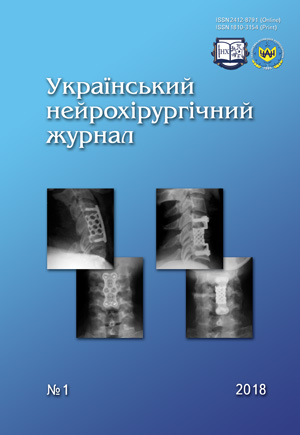Neurosurgery in Ukraine: nowadays and perspectives
DOI:
https://doi.org/10.25305/unj.117775Keywords:
neurosurgery in Ukraine, attainments, perspectivesAbstract
In 2016 in Ukraine 111 neurosurgery units with hospital bed capacity amounted to 3118 functioned. Over last 4 years (2013-2016) the level of hospitalization to neurosurgical units has increased by 7%, the volume of neurosurgery interventions rose by 9%. Surgical activity increased by 3.4%.
Overall in Ukraine some reduction in general and post-operative lethality is observed.
Whereas bed capacity in the SI Romodanov Neurosurgery Institute is 11.6% (361 out of 3118) of the total quantity of neurosurgery patient capacity the Institute performs two thirds of all high-technology (endoscopic, endovascular, laser interventions and those using neuro-navigation etc.) neurosurgery interventions with total and postoperative lethality indices 1.3% and 1.4% in 2017, respectively, which are the lowest indices ever the Institute has been existing and the history of nueroservice in the country. The number of high-technology interventions of IV and V degree of complexity out of total interventions in Neurosurgery Institute amounts to 72%.
In 2017 the task of the Government on implementation of innovative mechanisms of financing the institutes of NAMS of Ukraine so called pilot project was brought off.
The care at life threatening conditions (in different period from 50% to 74% hospitalized patients) – severe brain and spinal injuries, acute strokes is of top-priority for neurosurgery service.
Limitedness of budget financing determines the three directions in the development of specialty and activity of the Institute: 1) determination of priorities with full costing of certain neurosurgical units at the expense of reduced budgeting of others; 2) non-budgetary funding on the basis of public-private partnership with self-financing structures development; 3) the Institute functioning as an autonomous budgetary establishment (access to credits, self-financing activity etc.) is most perspective.
Certification of neurosurgical units, residency implementation by unified training module according to the recommendations of the European Association of Neurosurgical Societies (EANS) followed by licensing of professionals by the Ukrainian Association of Neurosurgeons and top neurosurgery physicians in the world are the necessary condition for improving secondary care.
References
1. Pedachenko EG, Danchyn OG, Polishchuk MYe, Tsymbalyuk VI. Orhanizatsiya nadannya spetsializovanoyi neyrokhirurhichnoyi dopomohy u viys’kovyy chas: Metodychni vkazivky. Kyiv: [publisher unknown]; 2014. Ukrainian.
2. Tsymbalyuk VI, Danchyn AO, Luzan BM, et al. Pryntsypy nadannya dopomohy pry boyovykh ushkodzhennyakh peryferychnykh nerviv: Metodychni rekomendatsiyi. Kyiv: [publisher unknown]; 2015. Ukrainian.
3. Pedachenko EG, Danchyn AO, Polishchuk MYe, et al. Orhanizatsiya nadannya spetsializovanoyi neyrokhirurhichnoyi dopomohy pry boyovykh travmakh khrebta i spynnoho mozku: Metodychni vkazivky. Kyiv: [publisher unknown]; 2014. Ukrainian.
4. Danchyn AO, Danchyn OG. Pryntsypy medychnoho sortuvannya, nadannya medychnoyi dopomohy ta vyznachennya cherhovosti evakuatsiyi poranenykh z boyovymy neyrokhirurhichnymy travmamy v systemi likuval’no-evakuatsiynoho zabezpechennya zbroynykh syl Ukrayiny: Metodychni vkazivky. Khomenko IP, editor. Kyiv: Lazurit Polygraph; 2016. Ukrainian.
5. Klinichnyy protokol nadannya medychnoyi dopomohy khvorym iz zbroynymy poranennyamy m’yakykh tkanyn holovy myrnoho chasu. Ukrainian Neurosurgical Journal. 2008;(3):147-148. Ukrainian. [Abstract/Full Text]
6. Klinichnyy protokol nadannya medychnoyi dopomohy khvorym iz zbroynymy nepronykayuchymy poranennyamy holovy myrnoho chasu. Ukrainian Neurosurgical Journal. 2008;(3):144-146. Ukrainian. [Abstract/Full Text]
7. Klinichnyy protokol nadannya medychnoyi dopomohy khvorym iz zbroynymy pronykayuchymy poranennyamy holovy myrnoho chasu. Ukrainian Neurosurgical Journal. 2008;(3):149-151. Ukrainian. [Abstract/Full Text]
8. Klinichnyy protokol nadannya medychnoyi dopomohy dityam iz zbroynymy poranennyamy m’yakykh tkanyn holovy myrnoho chasu. Ukrainian Neurosurgical Journal. 2008;(3):193-194. Ukrainian. [Abstract/Full Text]
9. Klinichnyy protokol nadannya medychnoyi dopomohy dityam iz zbroynymy nepronykayuchymy poranennyamy holovy myrnoho chasu. Ukrainian Neurosurgical Journal. 2008;(3):195-197. Ukrainian. [Abstract/Full Text]
10. Klinichnyy protokol nadannya medychnoyi dopomohy dityam iz zbroynymy pronykayuchymy poranennyamy holovy myrnoho chasu. Ukrainian Neurosurgical Journal. 2008;(3):198-200. Ukrainian. [Abstract/Full Text]
11. Polishchuk NE, Starcha VI. Ognestrel’nye raneniya golovy (illyustrirovannoe posobie). Kiev: TON; 1996. Russian.
12. Polishchuk MYe, Starcha VI, Slyn’ko YeI, Zaval’nyuk AKh. Vohnepal’ni ushkodzhennya tsentral’noyi nervovoyi systemy. Ternopil’: TDMU «Ukrmedknyha»; 2005. Ukrainian.
13. Tsymbalyuk VI, Mogila VV, Semkin KV, Kurteev SV. Oruzheyno-vzryvnye raneniya nervnoy sistemy. Tsymbalyuk VI, Mogila VV, editors. Simferopol: [publisher unknown]; 2008. Russian.
14. Pedachenko EG, Polishchuk MYe, Slyn’ko YeI, et al. Travmatychni ushkodzhennya khrebta i spynnoho mozku. Pedachenko EG, editor. Kyiv: Interservis; 2017. Ukrainian.
15. Sirko AG, Dzyak LA. Boyovi vohnepal’ni cherepno-mozkovi poranennya. Kyiv: TOV Perham; 2017. Ukrainian.
16. Danchyn AO, Polishchuk MYe, Kazmirchuk AP, Danchyn GO. Vohnepal’ni poranennya m’yakykh tkanyn sklepinnya cherepa. Kyiv: [publisher unknown]; 2017. Ukrainian.
17. Danchyn AO, Polishchuk MYe, Danchyn OG. Klasyfikatsiya vohnepal’nykh poranen’ cherepa ta holovnoho mozku. Forthcoming 2018.
Downloads
Published
How to Cite
Issue
Section
License
Copyright (c) 2018 Eugene G. Pedachenko

This work is licensed under a Creative Commons Attribution 4.0 International License.
Ukrainian Neurosurgical Journal abides by the CREATIVE COMMONS copyright rights and permissions for open access journals.
Authors, who are published in this Journal, agree to the following conditions:
1. The authors reserve the right to authorship of the work and pass the first publication right of this work to the Journal under the terms of Creative Commons Attribution License, which allows others to freely distribute the published research with the obligatory reference to the authors of the original work and the first publication of the work in this Journal.
2. The authors have the right to conclude separate supplement agreements that relate to non-exclusive work distribution in the form of which it has been published by the Journal (for example, to upload the work to the online storage of the Journal or publish it as part of a monograph), provided that the reference to the first publication of the work in this Journal is included.









